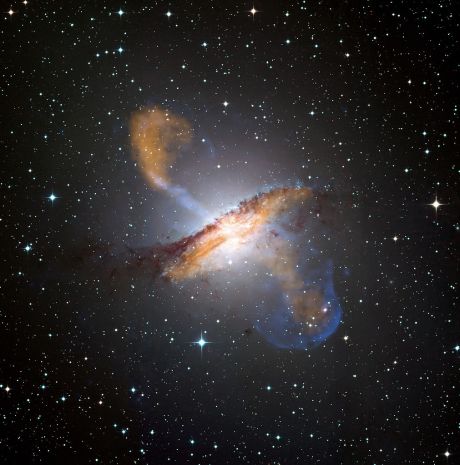Numerical simulations of the dark Universe

Black Hole Outflows From Centaurus
By ESO/WFI (Optical); MPIfR/ESO/APEX/A.Weiss et al. (Submillimetre); NASA/CXC/CfA/R.Kraft et al. (X-ray) Derivative work including grading and crop: Julian Herzog [CC BY 4.0 (http://creativecommons.org/licenses/by/4.0)], via Wikimedia Commons
Understanding the physics of the dark sector is one of the foremost challenges of cosmology today. New sophisticated simulations of the evolution of the Universe will play a crucial role in this endeavour.
The prevailing line of thinking says that our Universe is being shaped
by two mysterious entities that astronomers cannot directly observe or
measure: dark matter and dark energy. This makes it somewhat challenging
to determine if the current understanding of their perceived effects is
correct.
One of the ways scientists can gain confidence that they are not missing any relevant information for the correct interpretation of cosmological data is to run models of the Universe. Researchers working on the EU-funded project SIDUN (Simulating the dark Universe) ran simulations for various cosmological scenarios.
To reproduce details of the Universe's evolution, the researchers upgraded software for what are called hydrodynamics simulations, which treat the contents of the Universe as particles of a fluid. These cosmological simulations are mostly focused on competitive scenarios of interacting dark energy and modified gravity models.
But SIDUN scientists also combined simulations of the two different scenarios of the cosmic acceleration with extensions of the standard model, including massive neutrinos. The numerical models of cosmological inflation used provided a significant level of asymmetry in the primordial mass distribution.
The researchers hope that the results of these simulations will answer some still open questions about dark matter, dark energy and the overall structure of the cosmos. In particular, dark energy is purportedly driving the accelerating expansion of our Universe.
There are many different theories about dark energy. It could be a characteristic of gravity at large scales that has not been discovered yet. It could be a twist on general relativity that scientists have not thought of. The new crop of high-resolution simulations data should allow the capture of very subtle effects of dark energy.
SIDUN project results have already been included in the simulations planning of the Euclid mission of the European Space Agency (ESA) designed to map the dark Universe. These should help cosmologists rule out possible explanations as they try to zero in on a more accurate theory of how our Universe works.
published: 2015-10-30

